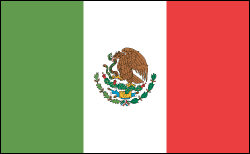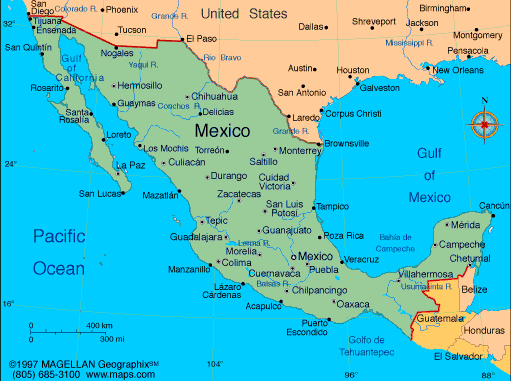MEXICO

Geography: Mexico is bordered by the United States to the north and Belize and Guatemala to the southeast. Mexico is about one-fifth the size of the United States. Baja California in the west is an 800-mile (1,287-km) peninsula that forms the Gulf of California. In the east are the Gulf of Mexico and the Bay of Campeche, which is formed by Mexico's other peninsula, the Yucatán. The center of Mexico is a great, high plateau, open to the north, with mountain chains on the east and west and with ocean-front lowlands beyond.
Government: Federal republic.
History: At least three great civilizations—the Mayas, the Olmecs, and the Toltecs—preceded the wealthy Aztec empire, conquered in 1519–1521 by the Spanish under Hernando Cortés. Spain ruled Mexico as part of the viceroyalty of New Spain for the next 300 years until Sept. 16, 1810, when the Mexicans first revolted. They won independence in 1821.
From 1821 to 1877, there were two emperors, several dictators, and enough presidents and provisional executives to make a new government on the average of every nine months. Mexico lost Texas (1836), and after defeat in the war with the U.S. (1846–1848), it lost the area that is now California, Nevada, and Utah, most of Arizona and New Mexico, and parts of Wyoming and Colorado under the Treaty of Guadalupe Hidalgo. In 1855, the Indian patriot Benito Juárez began a series of reforms, including the disestablishment of the Catholic Church, which owned vast property. The subsequent civil war was interrupted by the French invasion of Mexico (1861) and the crowning of Maximilian of Austria as emperor (1864). He was overthrown and executed by forces under Juárez, who again became president in 1867.

Map of Mexico
President: Enrique Peña Nieto (2012)
Land area: 742,485 sq mi (1,923,039 sq
km); total area: 761,602 sq mi (1,972,550 sq km)
Population (2014 est.): 120,286,655 (growth
rate: 1.21%); birth rate: 19.02/1000; infant mortality rate: 12.58/1000;
life expectancy: 75.43
Capital and largest city (2011 est.):
Mexico City, 20.446 million
Other large cities:
Guadalajara 4.525 million; Monterrey 4.213 million; Puebla 2.335
million; Tijuana 1.82 million; Toluca de Lerdo 1.748 million (2011)
Monetary unit: Mexican peso
Official
name: Estados Unidos Mexicanos
Languages:
Spanish only 92.7%, Spanish and indigenous languages 5.7%, indigenous only 0.8%, unspecified 0.8%
note: indigenous languages include various Mayan, Nahuatl, and other regional languages (2005)
Ethnicity/race:
mestizo (Amerindian-Spanish) 60%, Amerindian or
predominantly Amerindian 30%, white 9%, other 1%
Religions:
Roman Catholic 82.7%, Pentecostal 1.6%, Jehovah's
Witnesses 1.4%, other Evangelical Churches 5%, other 1.9%, none 4.7%,
unspecified 2.7% (2010 est.)
National Holiday:
Independence Day, September 16
Literacy rate: 93.5% (2011 est.)
Economic summary: GDP/PPP (2013 est.):
$1.2 trillion; per capita $15,600. Real growth rate: 1.25%.
Inflation: 4%. Unemployment: 4.9% plus underemployment
of perhaps 25%. Arable land: 12.98%. Agriculture: corn,
wheat, soybeans, rice, beans, cotton, coffee, fruit, tomatoes; beef,
poultry, dairy products; wood products. Labor force: 51.48
million; agriculture 13.4%, industry 24.1%, services 61.9% (2011).
Industries: food and beverages, tobacco, chemicals, iron and
steel, petroleum, mining, textiles, clothing, motor vehicles, consumer
durables, tourism. Natural resources: petroleum, silver,
copper, gold, lead, zinc, natural gas, timber. Exports: $370.9
billion (2013 est.): manufactured goods, oil and oil products,
silver, fruits, vegetables, coffee, cotton. Imports: $370.7
billion (2013 est.): metalworking machines, steel mill
products, agricultural machinery, electrical equipment, car parts for
assembly, repair parts for motor vehicles, aircraft, and aircraft
parts. Major trading partners: U.S., China, Japan (2012).
Communications:
Telephones: main lines in use: 20.22 million (2012); mobile
cellular: 100.786 million (2012). Broadcast media: many
TV stations and more than 1,400 radio stations with most privately
owned; the Televisa group once had a virtual monopoly in TV
broadcasting, but new broadcasting groups and foreign satellite and
cable operators are now available (2012). Internet Service Providers
(ISPs): 16.233 million (2012). Internet users: 31.02 million
(2009).
Transportation: Railways:
total: 17,665 km (2008). Highways: total: 377,660 km; paved:
137,544 km (including 7,176 km of expressways); unpaved: 240,116 km
(2004). Waterways: 2,900 km navigable rivers and coastal
canals. major seaports: Altamira, Coatzacoalcos, Lazaro Cardenas, Manzanillo, Salina Cruz, Veracruz.
Airports: 1,714 (2013).
International disputes: abundant
rainfall in recent years along much of the Mexico-US border region has
ameliorated periodically strained water-sharing arrangements; the US has
intensified security measures to monitor and control legal and illegal
personnel, transport, and commodities across its border with Mexico;
Mexico must deal with thousands of impoverished Guatemalans and other
Central Americans who cross the porous border looking for work in Mexico
and the United States; Belize and Mexico are working to solve minor
border demarcation discrepancies arising from inaccuracies in the 1898
border treaty.
-------------------- o --------------------
No comments:
Post a Comment